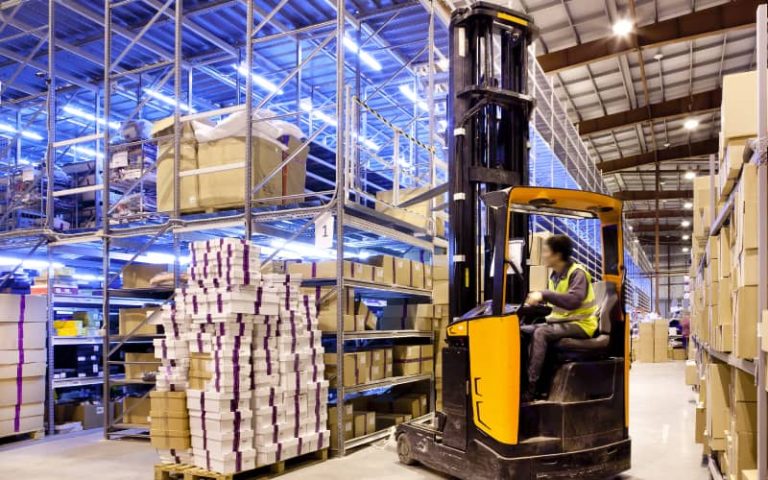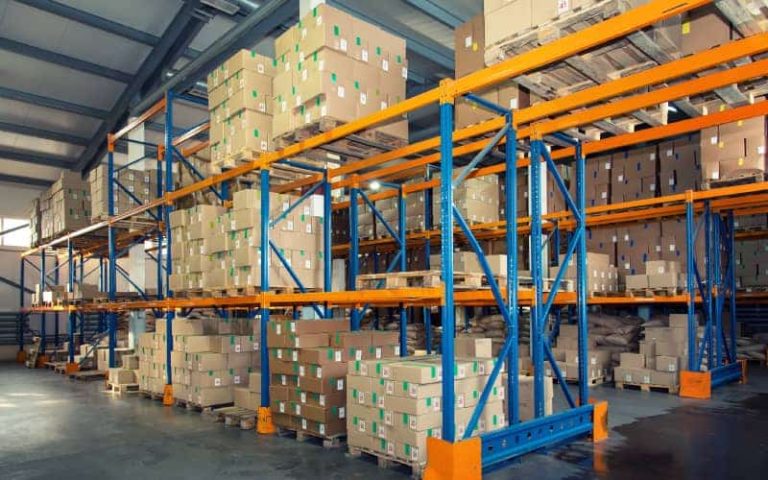The types of pallet racks you choose and how you configure them play a key role in warehouse efficiency—regardless of the warehouse’s size. The materials handling experts at Conesco Storage Systems can help you design, purchase, configure, and install the right setup for your unique environment.
Here is a complete roadmap for making the right decisions about pallet racking for your warehouse.
The Benefits of Pallet Racking
Pallet racking is an incredibly efficient way to store items in warehouses, distribution centers, and fulfillment centers. They maximize storage by taking advantage of vertical space so you can store more inventory in a much smaller footprint. This optimizes storage while allowing for greater organization and accessibility—streamlining workflow.
Pallet racking contributes to a safe work environment. Built-in safety features and strong, durable construction reduce the risk of accidents or injuries.
Other benefits include:
- Enhanced inventory control and visibility
- Flexibility for accommodating various types of inventory
- Scalability to adapt to changing storage needs
- Better utilization of warehouse space
- Customization options for specific warehouse requirements
- Contribution to overall warehouse productivity and efficiency
What Is the Most Widely Used Pallet Racking System?
Single-deep selective pallet racks are the most commonly used pallet rack systems in warehouses. They are highly cost-efficient and are adjustable for different sizes and weights. Warehouse teams get easy access to inventory. Single-deep pallet racks can also be configured back-to-back to reduce aisle space.
However, there are other options for pallet racking.
What is the difference between pallet racking shelving?
Let’s take a look at the different types of pellet racks you can use.
Types of Pallet Racks
Other types of pallet racks include:
- Double-deep racking systems: Features a second row, providing deeper storage space. For example, you can put two pallets in the same row on a shelf rather than one. You will need a specialized forklift to reach the upper levels.
- Drive-in racks: Drive-in racks allow forklifts to drive into the pallet rack and store multiple items on rails. Forklifts can then back out the same way they entered. Works well for LIFO (last in, first out) stock rotation.
- Drive-through racks: Forklifts can access both ends of the aisle, one side is used for loading while the other for unloading. Works well for first in, first out (FIFO) inventory management.
- Push-back racks: High-density storage systems where racks are loaded onto a wheeled cart system that rolls on inclined rails in each lane. Carts are pushed back into position by gravity.
- Pallet flow racks: High-density storage on roller conveyors. Pallet flow racks allow loading on one end and unloading on the other.
- Mobile pallet racks: Compact storage racks on rail systems attached to flooring. Racks are on wheels and can be moved on floor rails. This is effective for areas where space is at a premium.
- Cantilever racks: Specialized racks for storing long or bulky items. Cantilever racks are often used for lumber, material sheets, and PVC pipes.
There are pros and cons for each type of pallet racking solution. The materials handling experts at Conesco Storage System can find the right fit for you and optimize your warehouse layout for peak efficiency.
Assessing Your Pallet Racking Needs and Layout
There are many options for the types of pallet racking you can buy and how you can configure your warehouse space. You will want to evaluate how the pallet racking system integrates with your warehouse layout to optimize workflow and maximize space utilization.
Here are some of the other key factors you need to consider.
Storage Density
Consider the quantity and size of SKUs to determine the appropriate pallet rack type. You need to balance storage density with ease of access to ensure efficient storage and retrieval within the warehouse.
Weight Loads
Safe storage requires pallet racking that is rated to handle weight loads for an extended period. Keep in mind that it is not always possible to have uniform weight distribution with the flow of goods onto and off pallet racks. There will be load fluctuations, so be sure to choose a racking system that can handle uneven weight distribution.
Inventory Turnover
Choose between systems based on inventory control needs. LIFO suits drive-in or push-back racks, and FIFO suits pallet flow racks.
Forklift/Pallet Jack Access
Confirm compatibility with forklifts, especially for systems like drive-through or double-deep racks. Assess compatibility with other material handling equipment such as pallet jacks or automated systems, to ensure smooth operations.
Aisle Width
Select aisle width (very narrow, narrow, or wide) based on load requirement, forklift fleet, and storage type.
Rack Decking
Additional components like decking and pallet support enhance safety and protection for both racks and stored products.
Safety
Look for features like load capacity labels, beam locking mechanisms, and seismic bracing to enhance safety and compliance with regulations.
Seismic Zone
Find out if the facility is in a seismic zone. If so, look for high-grade materials designed for areas prone to earthquakes.
Ceiling Height
Evaluate the vertical space available to ensure the chosen pallet racking system can maximize storage capacity without interfering with building structures or sprinkler systems.
Environmental Factors
Consider factors such as humidity, temperature, and exposure to corrosive materials, which could impact the durability and longevity of the pallet racking system.
Future Needs
Consider the ability of your pallet racking system to accommodate future growth or changes in inventory volume or types.
Buy New or Used Pallet Racking?
New pallet racking has advantages when it comes to reliability, performance, and safety features but comes at a higher upfront investment. Used racking can provide substantial cost savings and quick availability, but may come with more uncertainty regarding condition and technology.
Weighing your budget, requirements, and future plans can help you determine if new or used is the better option.
New Pallet Racking
- Pros: Reliable, optimal performance, warranty coverage, advanced safety features, improved ergonomics and energy efficiency.
- Cons: More expensive upfront, quick depreciation in first few years, potentially longer lead times.
Used Pallet Racking
- Pros: Significant cost savings compared to new, often readily available to avoid lead times, wide selection allows finding what you need.
- Cons: May have hidden issues not obvious upon purchase, outdated technology efficiency, and shorter remaining lifespan means repairs/replacements are needed sooner.
High-quality used pallet racks do not stay on the market long, so inventory changes quickly.
What to Look for in a Pallet Racking Supplier
You are making a significant investment in pallet racking, so make sure you work with the right partner to help you get exactly what you need. Here are some of the key ways you need to evaluate a pallet racking supplier.
Experience and Reputation
Start by assessing the distributor’s industry experience and reputation. Seek out distributors with a solid track record and positive feedback from previous clients, as their experience and reliability can significantly impact the success of your project.
Ask for references and follow-up to validate the distributor’s reliability and performance, which provides insights into the company’s capabilities and service quality.
Product Quality and Selection
Examine the quality and diversity of the pallet racking systems offered by the distributor. Ensure the company provides high-quality products from top manufacturers and offers plenty of options to meet your storage needs.
Services and Support
Consider the services and support offered. Look for those who provide comprehensive installation services to ensure proper safety standards setup and compliance. Also, inquire into their level of customer support, including assistance with product selection, ongoing maintenance, and troubleshooting.
Price and Value
Compare pricing to find competitive rates without compromising on quality or service. Consider the overall value offered.
Location and Accessibility
The distributor’s location in relation to your warehouse can impact shipping costs and delivery times. Choosing a supplier with convenient accessibility can streamline logistics throughout the project.
Safety and Compliance
Ensure the distributor adheres to industry standards and regulations regarding pallet racking safety and compliance. Choosing a distributor with a strong commitment to safety helps mitigate risks and extend product lifecycle.
Sustainability Practices
If environmental sustainability is a business priority, inquire about the distributor’s sustainability practices and the eco-friendliness of their products. Choosing a distributor with sustainable practices can align with your company’s values and contribute to environmental conservation efforts.
Finding the Best Pallet Racking for Sale
Finding the best pallet racking for sale does not have to be difficult. Call the warehouse experts at Conesco Storage Systems. Whether you are looking for pallet racks in Los Angeles, pallet racks in Houston, warehouse racks in San Antonio, or anywhere else nationwide, Conesco Storage Systems is a leading supplier of materials handling equipment.
We can get you new pallet racks from top manufacturers at affordable prices or find high-quality used warehouse equipment for significant savings. Leveraging a nationwide network and deep industry connections, Conesco can help you design, install, and configure an optimal warehouse layout for peak efficiency.
Case Study: Pallet Racking Teardown Services
Conesco Storage Systems conducted an extra-large selective rack project involving decommissioning, purchase, labor for teardown/stacking/banding/loading, and sale of high-quality used pallet racking from a distribution center in Bolingbrook, IL.
Over 45 days, Conesco purchased more than $1 million of pallet racking materials, provided labor services to dismantle and remove 3,875 uprights and 37,000+ beams, and then sold the racking to four customers seeking cost savings. Conesco enabled the timely exit of the distribution center tenant by clearing the facility before the deadline, allowing the next stage of the facility turnover process to proceed on schedule.
We can handle teardowns efficiently. In fact, we had to pause for a week at the facility’s request because our crews were so far ahead of schedule.
Buyers got high-quality used pallet racking at a significant discount. They also used Conesco’s warehouse design services to optimize their layouts and were up and running quickly.
Whether you are looking to tear down, change over, liquidate, or buy new or used pallet racking, Conesco Storage Systems can do it all.
Frequently Asked Questions — FAQs
Is it safe to walk under pallet racking?
Walking under pallet racking can be hazardous, especially if there is a risk of items falling from above. It is generally not recommended unless safety measures like barriers, netting, or proper training are in place to mitigate risks.
Can you install pallet racking yourself?
You can, but it is not a good idea. Rely on professional materials handling installers that have years of experience in pallet racking assembly. Correct installation is crucial for both safety and structural integrity.
Does pallet racking need to be certified?
In most locations, pallet racking does not need to be certified. The Rack Manufacturers Institute (RMI) has a voluntary R-Mark certification that acknowledges the design, manufacture, and installation of industrial rack storage systems that comply with ANSI standards
OSHA has few regulations when it comes to warehouse racking, but you are required to facilitate a safe work environment that is “free from serious recognized hazards.” Before using pallet racks, you should have professionals inspect and validate safety codes and weight limits for safe operation.
What can I use instead of pallet racking?
Alternatives like industrial shelving or metal warehouse shelves can store lighter loads. Depending on your storage needs and space constraints, alternatives to pallet racking include shelving systems, carousels, mezzanines, cantilever racks, conveyors, and automated storage and retrieval systems (AS/RS).
How much does double deep pallet racking cost?
The cost of double deep pallet racking varies depending on factors such as size, capacity, materials, and additional features. Your best bet is to talk to Conesco Storage Systems to get pricing based on your needs and configuration.
How many pallets can a single pallet rack store?
Generally, a standard selective pallet rack can hold three to four per shelf level, with multiple levels per rack. Higher-density racks will be able to store greater capacity.
Call the Conesco team at (303) 690-9591 or request a consultation online to discuss your pallet racking needs.



